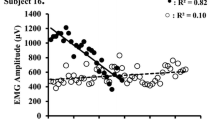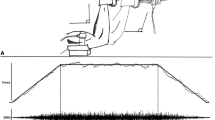Abstract
The purpose of this study was to compare the electromyographic fatigue threshold (EMGFT) values determined simultaneously from superficial elbow flexor muscles during an isometric single-joint task. Eight subjects performed isometric elbow flexions at randomly ordered percentages of maximal voluntary contraction (20, 30, 40, 50 and 60%). During these bouts, electromyographic (EMG) activity was measured in the anterior head of Deltoïd, lateral head of Triceps brachii, Brachioradialis and both short and long head of Biceps brachii. For each subject and each muscle, the EMG amplitude data were plotted as function of time for the five submaximal bouts. The slope coefficient of the EMG amplitude versus time linear relationships were plotted against force level. EMGFT was determined as the y-intercept of this relationship and considered as valid only if the following criteria were met: (1) significant positive linear regression (P < 0.05) between force and slope coefficient, (2) an adjusted coefficient of determination for force versus slope coefficient relationship greater than 0.85, and (3) a standard error for the EMGFT below 5% of maximal voluntary contraction. The EMGFT could only be determined for one muscle (the long head of Biceps brachii) and only in three out of the eight subjects (mean value = 24.9 ± 1.1% of maximal voluntary contraction). The lack of EMGFT in most of the subjects (5/8) could be explained by putative compensations between elbow muscles which were indirectly observed in some subjects. In this way, EMGFT should be studied from a more simple movement i.e., ideally a movement implying mainly one muscle.





Similar content being viewed by others
References
Bernstein N (1967) Coordination and regulation of movements. Pergamon Press, New York
Bigland-Ritchie B, Woods JJ (1984) Changes in muscle contractile properties and neural control during human muscular fatigue. Muscle Nerve 7:691–699. doi:10.1002/mus.880070902
Cardozo AC, Goncalves M (2003) Electromyographic fatigue threshold of erector spinae muscle induced by a muscular endurance test in health men. Electromyogr Clin Neurophysiol 43:377–380
Chao EYS, An KN, Cooner WP, Linscheid RL (1989) Biomechanis of hand. World scientific, Singapore, pp 31–51
Chiti L, Biondi G, Morelot-Panzini C, Raux M, Similowski T, Hug F (2008) Scalene muscle activity during progressive inspiratory loading under pressure support ventilation in normal humans. Respir Physiol Neurobiol 164:441–448. doi:10.1016/j.resp.2008.09.010
DeVries HA (1968) Method for evaluation of muscle fatigue and endurance from electromyographic fatigue curves. Am J Phys Med 47:125–135
deVries HA, Moritani T, Nagata A, Magnussen K (1982) The relation between critical power and neuromuscular fatigue as estimated from electromyographic data. Ergonomics 25:783–791
Dias da Silva SR, Goncalves M (2006) Dynamic and isometric protocols of knee extension: effect of fatigue on the EMG signal. Electromyogr Clin Neurophysiol 46:35–42
Edwards RG, Lippold OC (1956) The relation between force and integrated electrical activity in fatigued muscle. J Physiol 132:677–681
Farina D, Merletti R, Enoka RM (2004) The extraction of neural strategies from the surface EMG. J Appl Physiol 96:1486–1495
Garland SJ, Enoka RM, Serrano LP, Robinson GA (1994) Behavior of motor units in human biceps brachii during a submaximal fatiguing contraction. J Appl Physiol 76:2411–2419
Garland SJ, Griffin L, Ivanova T (1997) Motor unit discharge rate is not associated with muscle relaxation time in sustained submaximal contractions in humans. Neurosci Lett 239:25–28
Graef JL, Smith AE, Kendall KL, Walter AA, Moon JR, Lockwood CM, Beck TW, Cramer JT, Stout JR (2008) The relationships among endurance performance measures as estimated from VO2PEAK, ventilatory threshold, and electromyographic fatigue threshold: a relationship design. Dyn Med 7:15
Hendrix CR, Housh TJ, Johnson GO, Weir JP, Beck TW, Malek MH, Mielke M, Schmidt RJ (2009) A comparison of critical force and electromyographic fatigue threshold for isometric muscle actions of the forearm flexors. Eur J Appl Physiol 105:333–342
Hermens HJ, Freriks B, Disselhorst-Klug C, Rau G (2000) Development of recommendations for SEMG sensors and sensor placement procedures. J Electromyogr Kinesiol 10:361–374
Housh TJ, deVries HA, Johnson GO, Housh DJ, Evans SA, Stout JR, Evetovich TK, Bradway RM (1995) Electromyographic fatigue thresholds of the superficial muscles of the quadriceps femoris. Eur J Appl Physiol Occup Physiol 71:131–136
Hug F, Dorel S (2009) Electromyographic analysis of pedaling: a review. J Electromyogr Kinesiol 19:182–198
Hug F, Drouet JM, Champoux Y, Couturier A, Dorel S (2008) Interindividual variability of electromyographic patterns and pedal force profiles in trained cyclists. Eur J Appl Physiol 104:667–678
Hunter SK, Lepers R, MacGillis CJ, Enoka RM (2003) Activation among the elbow flexor muscles differs when maintaining arm position during a fatiguing contraction. J Appl Physiol 94:2439–2447
Hunter SK, Critchlow A, Shin IS, Enoka RM (2004) Fatigability of the elbow flexor muscles for a sustained submaximal contraction is similar in men and women matched for strength. J Appl Physiol 96:195–202
Johnson MA, Polgar J, Weightman D, Appleton D (1973) Data on the distribution of fibre types in thirty-six human muscles; an autopsy study. J Neurol Sci 18:111–129
Matsumoto T, Ito K, Moritani T (1991) The relationship between anaerobic threshold and electromyographic fatigue threshold in college women. Eur J Appl Physiol Occup Physiol 63:1–5
Moritani T, Takaishi T, Matsumoto T (1993) Determination of maximal power output at neuromuscular fatigue threshold. J Appl Physiol 74:1729–1734
Murray WM, Delp SL, Buchanan TS (1995) Variation of muscle moment arms with elbow and forearm position. J Biomech 28:513–525
Pavlat DJ, Housh TJ, Johnson GO, Schmidt RJ, Eckerson JM (1993) An examination of the electromyographic fatigue threshold test. Eur J Appl Physiol Occup Physiol 67:305–308
Pringle JS, Jones AM (2002) Maximal lactate steady state, critical power and EMG during cycling. Eur J Appl Physiol 88:214–226
Psek JA, Cafarelli E (1993) Behavior of coactive muscles during fatigue. J Appl Physiol 74:170–175
Rudroff T, Christou EA, Poston B, Bojsen-Moller J, Enoka RM (2007) Time to failure of a sustained contraction is predicted by target torque and initial electromyographic bursts in elbow flexor muscles. Muscle Nerve 35:657–666
Rudroff T, Staudenmann D, Enoka RM (2008) Electromyographic measures of muscle activation and changes in muscle architecture of human elbow flexors during fatiguing contractions. J Appl Physiol 104:1720–1726
Smith AE, Moon JR, Kendall KL, Graef JL, Lockwood CM, Walter AA, Beck TW, Cramer JT, Stout JR (2009) The effects of beta-alanine supplementation and high-intensity interval training on neuromuscular fatigue and muscle function. Eur J Appl Physiol 105:357–363
van Bolhuis BM, Gielen CC (1999) A comparison of models explaining muscle activation patterns for isometric contractions. Biol Cybern 81:249–261
Acknowledgments
The authors are grateful for Benjamin BAGUET and Morgan REMAUD for their technical assitance in this study. They also thank Philippe SARRAZIN for its technical assistance (design of the ergometer) and Jean HUG for drawing Fig. 1.
Author information
Authors and Affiliations
Corresponding author
Rights and permissions
About this article
Cite this article
Hug, F., Nordez, A. & Guével, A. Can the electromyographic fatigue threshold be determined from superficial elbow flexor muscles during an isometric single-joint task?. Eur J Appl Physiol 107, 193–201 (2009). https://doi.org/10.1007/s00421-009-1114-6
Accepted:
Published:
Issue Date:
DOI: https://doi.org/10.1007/s00421-009-1114-6




